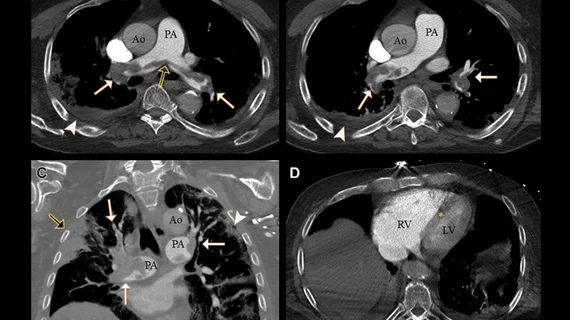'Concerning' CT findings may lead to unnecessary hospitalization in PE patients
CT findings could cause patients with low-risk pulmonary embolism to be hospitalized unnecessarily, according to new data shared in JAMA.
Experts at Michigan Medicine recently compared the outcomes of patients with low-risk PE with “concerning” imaging who were hospitalized to those who were cared for as outpatients. In terms of adverse clinical outcomes, the group found that those who had been hospitalized had little to no advantage over those who managed their condition at home. This could indicate that CT findings that have historically been deemed as concerning relative to PE might not hold as much weight when it comes to associated risks as previously thought, the experts suggested [1].
“The results of this study are going to come as a surprise to most emergency physicians, who have been taught for years to regard large, centrally located, or ‘saddle’ PEs as true medical emergencies,” said the study’s senior author Colin Greineder, MD, PhD, an assistant professor of emergency medicine and pharmacology at University of Michigan Medical School. “In fact, our findings suggest that CT findings alone might not confer as much risk as we thought.”
The team retrospectively analyzed data from 817 cases of acute PE that initially presented to the emergency department at UM Health between 2016 and 2019. All-cause mortality, rates of hospitalization, length of stay, need for intensive care, imaging and other measures were compared between the two groups to determine whether those who were treated as inpatients for low-risk PE fared any better than those who were treated as outpatients.
Of the 817 patients included, 40.5% were considered low-risk based on PE Severity Index (PESI) scores and 151 of those patients had CT findings considered concerning. Those patients were more likely to be hospitalized, but their rate of adverse outcomes was very similar to those who were discharged from the ED. Adverse outcomes (30-day deaths) were observed in 0 of 151 hospitalized patients versus 4 of 180 outpatients.
These findings further support growing evidence that low-risk PE patients, even those with concerning imaging, can safely be managed at home in many cases, Greineder suggested.
“We have tools like the Pulmonary Embolism Severity Index and biomarkers that allow for appropriate management of these patients, but they do not typically include those ‘concerning’ CT findings,” Greineder said. “Our report suggests that these imaging findings may be an important barrier to safe discharge.”
If confirmed in further research at other institutions, efforts will need to be made to implement more appropriate risk assessments regarding CT imaging in otherwise low-risk PE patients, the group suggested.

